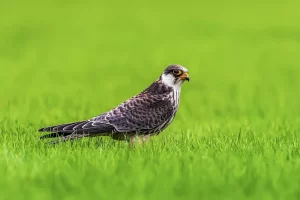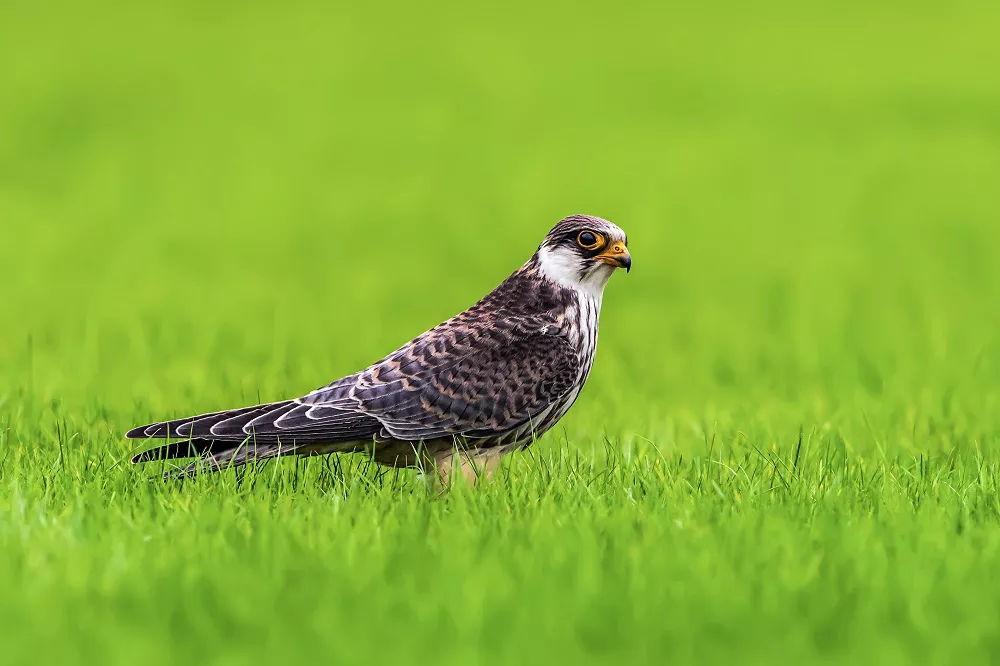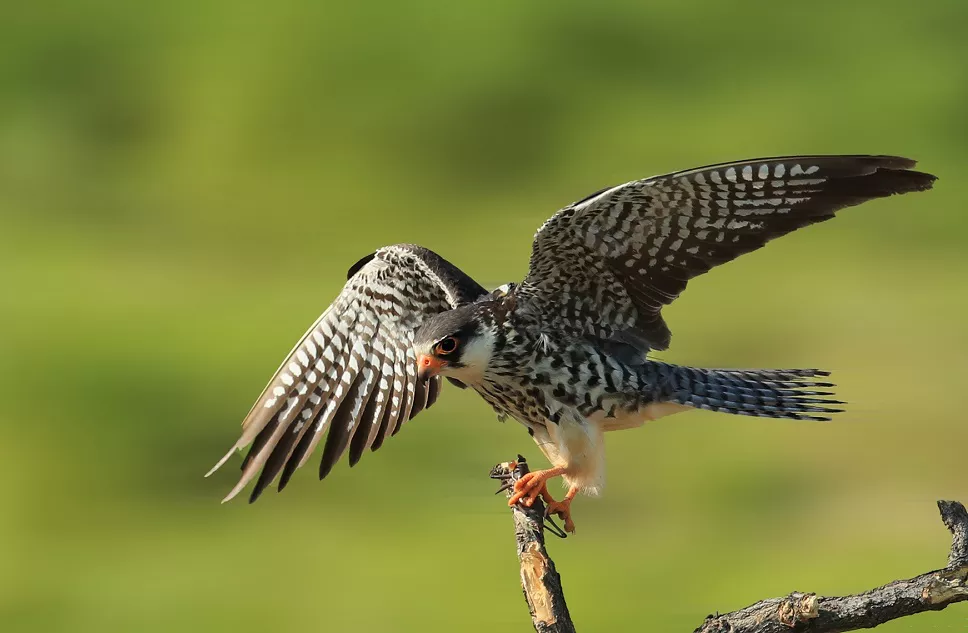
Amur Falcon on the grass
The Amur Falcon (Falco amurensis) is a small, migratory bird of prey native to East Asia. Known for its remarkable long-distance migration, it travels from Siberia to southern Africa annually. Agile and fast-flying, it preys on insects, especially locusts, helping control pest populations. Its striking appearance includes a slender body and a distinctive dark cap.
Amur Falcon Physical Characteristics
The Amur Falcon (Falco amurensis) is a medium-sized bird of prey known for its remarkable migration and aerial skills. Here is a detailed look at its physical features:
Size
Length: 29–34 cm (11.4–13.4 inches)
Wingspan: 65–80 cm (25.6–31.5 inches)
Weight: 130–200 grams (4.6–7.1 ounces)
Despite its relatively small size, the Amur Falcon is built for agile flight, making it a formidable hunter.
Plumage
Adult Males:
- The male Amur Falcon is distinguished by a greyish-blue plumage on its back and wings.
- The underside is pale with a reddish-brown or orange hue on the breast.
- A blackish tail with white tips adds to the male’s sharp appearance.
Adult Females:
- Females have a brownish-grey back and wings, with streaks and spots on the chest and belly.
- Their tail is similarly dark but with a more noticeable streaking pattern.
- The feathers are more muted in tone compared to the males, aiding in camouflage while nesting.
Head and Beak
- The Amur Falcon has a small, rounded head with a sharp, hooked beak, typical of falcons. This beak is used for catching and eating small birds and insects.
- Eyes: Large, dark, and slightly forward-facing, the eyes provide excellent vision for spotting prey from a distance.
Legs and Feet
- The legs are yellow and relatively long, which help the bird grasp and secure prey.
- The feet are equipped with powerful talons, essential for seizing prey mid-flight or on the ground.
Flight Features
- Wings: The Amur Falcon’s wings are long, pointed, and narrow, adapted for fast, agile flight. This allows them to make sharp turns and quick dives, essential for catching small birds and insects.
- The tail is long and forked, helping the bird maintain stability and maneuverability while in flight.
Sexual Dimorphism
The males are more colorful and striking, with greyish-blue feathers, while the females have more subdued brown tones. This dimorphism is typical of many raptor species, with males often displaying brighter colors to attract mates.
Amur Falcon Habitat and Migration
The Amur Falcon (Falco amurensis) is a small, migratory bird of prey primarily found in East Asia. It is known for its long-distance migration and remarkable adaptability to various habitats.
Amur Falcon Habitat
The Amur Falcon primarily inhabits areas in East Asia, specifically around the Amur River basin, which is located on the border between Russia and China. During the breeding season, the falcon is often found in open woodlands, grasslands, and forest edges, particularly in areas where they can easily hunt for small birds and insects.
Key Habitat Features:
Grasslands and Open Woodland: Amur Falcons are typically found in open areas with some form of vegetation, which provides cover and food sources for hunting.
Rocky Outcrops and Cliff Edges: During migration, these birds may use cliffs and other high vantage points as stopover points for resting and hunting.
Tree Groves: They also use tree groves for nesting purposes, particularly during the breeding season.
Migration of the Amur Falcon
One of the most notable features of the Amur Falcon is its long-distance migration. This bird is known for traveling between its breeding grounds in Eastern Russia and Northern China and its wintering grounds in Sub-Saharan Africa.
Breeding and Wintering Grounds:
Breeding Grounds: In the summer, the Amur Falcon breeds in the temperate regions of eastern Russia and northern China, specifically near the Amur River.
Wintering Grounds: After breeding, the Amur Falcon migrates south, traveling to Sub-Saharan Africa, particularly in countries such as Ethiopia, Kenya, Tanzania, and other parts of East Africa.
Migration Routes:
The migration route of the Amur Falcon spans approximately 10,000 kilometers (6,200 miles). They are known to follow the eastward path across the Himalayas and the Arabian Peninsula, reaching their wintering grounds in Africa.
Stopover Points: During their migration, Amur Falcons stop at various points along the way to rest and feed. These include India, Sri Lanka, and the Middle East.
Migration Timing:
Autumn Migration: Amur Falcons typically begin their southward migration in September and reach their wintering grounds by October.
Spring Migration: In the spring, they start migrating back to their breeding grounds around March to April.
Amur Falcon Diet and Hunting
Amur Falcon Diet
The Amur Falcon is primarily an insectivorous bird, with a diet that consists mainly of insects. During their stopover in Northeast India, their diet is dominated by termites, particularly species like Odontotermes feae and O. horni, which make up about 87% of their prey. In addition to termites, they also consume other insects such as beetles, ants, and dragonflies. While in their breeding range, they may also feed their young with small birds, mammals, and amphibians.
Amur Falcon Hunting Behavior
Amur Falcons are skilled hunters that capture most of their prey in flight, often by hovering or swooping down on insects in the air or on the ground. They are active hunters, particularly during late evenings and early mornings. Their hunting strategy is opportunistic, taking advantage of abundant insect swarms, such as those of termites and dragonflies, which provide essential energy for their long migrations.
Amur Falcon Conservation Status
Historically, Amur Falcons were hunted in large numbers, particularly in Northeast India, where they congregated during their migrations. The birds were valued for their meat and were also traded locally. However, conservation efforts have shifted local attitudes towards protecting these birds, with communities transitioning from hunting to conservation practices. The availability of abundant insect prey, especially termites, is crucial for the successful migration of Amur Falcons, highlighting the importance of preserving their stopover habitats.
Amur Falcon Photos
5 Interesting Facts about the Amur Falcon
The Amur falcon (Falco amurensis) is a remarkable bird of prey known for its extensive migratory journey and distinctive physical characteristics. Here are 5 intriguing facts about this species:
1. Migration: Amur falcons undertake one of the longest migrations among raptors, traveling from their breeding grounds in southeastern Siberia and northern China to winter in southern and eastern Africa. This journey spans approximately 4,800 kilometers (3,000 miles) and includes a notable overwater passage across the Arabian Sea.
2. Physical Appearance: Males are characterized by dark sooty grey plumage with rufous thighs and vent, while females have a dark spotted chest and vent against a white background, with a darker grey back. Both sexes feature an orange eye-ring, cere (the base of the beak), and feet.
3. Diet: During migration, Amur falcons primarily feed on insects, including termites, locusts, ants, and beetles, which are abundant in Africa following tropical storms. They capture most of their prey in flight, sometimes by hovering, and will also pick prey by alighting on the ground.
4. Conservation Status: The Amur falcon is currently classified as a species of Least Concern due to its wide breeding range and large population size. However, during migration, they are vulnerable to hunting in parts of northeastern India and eastern Africa. Conservation efforts have been implemented to protect these birds, including campaigns to prevent hunting in certain regions.
5. Nesting: Amur falcons do not build their own nests; instead, they utilize abandoned nest platforms of other birds of prey or corvids, as well as tree hollows. The breeding season occurs from May to June, with both parents taking turns to incubate and feed the chicks, which hatch after about a month.
You May Also Like
The Amur Falcon (Falco amurensis) and Red-Footed Falcon (Falco vespertinus) are two species of small falcons that belong to the same family, Falconidae. These birds are known for their impressive …
The Amur Falcon, scientifically known as Falco amurensis, is a small bird of prey that breeds in Siberia and northern China and migrates to southern Africa and India during the …



 Facebook
Facebook  Instagram
Instagram  Youtube
Youtube 